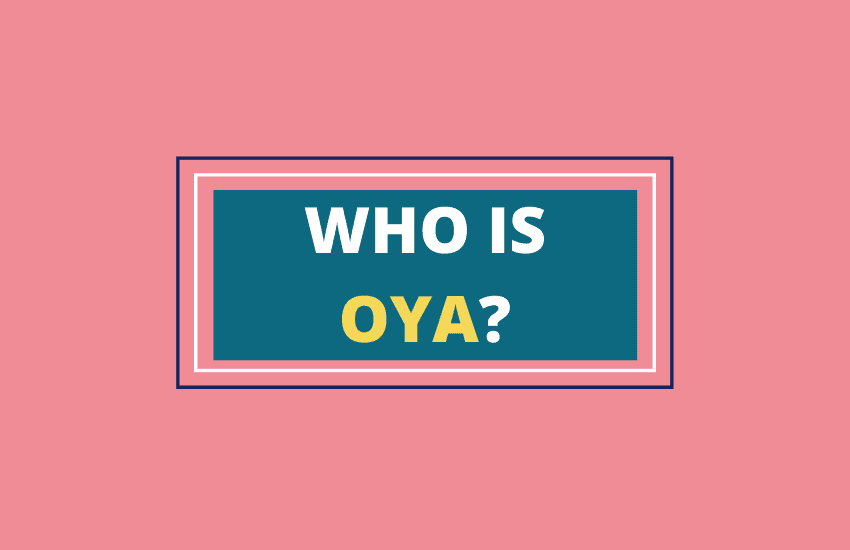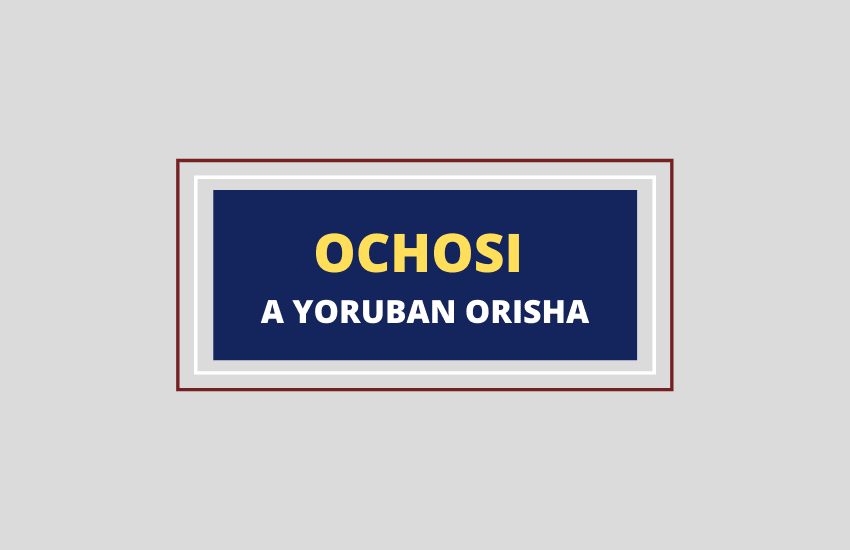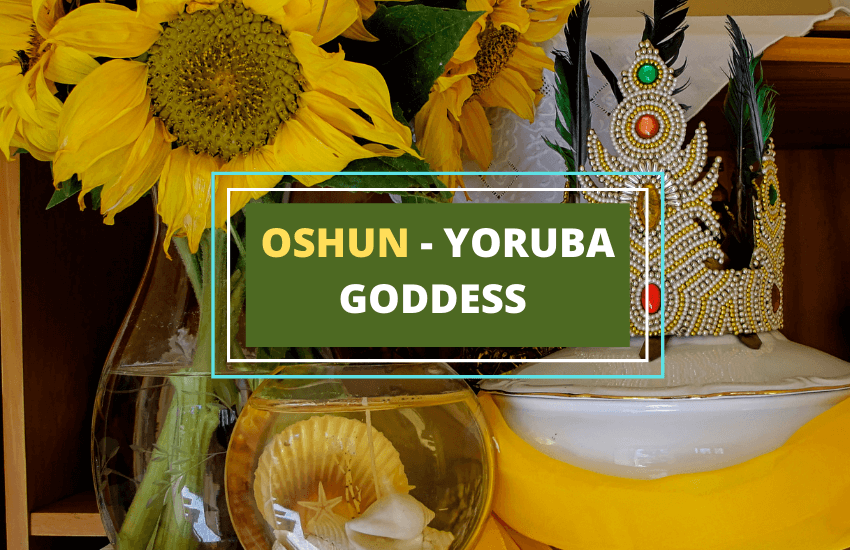
Table of Contents
Oshun, also known as Oxum and Ochún, is a supreme being or Orisha of the Yoruba people – the largest ethnic group of southwestern Nigeria. In the Yoruba religion, she’s also called the river goddess and is commonly associated with fresh and sweet waters, love, purity, prosperity, fertility, and beauty.
She’s the most prominent and venerated of all the Orishas but is considered to possess some human traits as well, such as perseverance, but also vanity.
What is the Yoruba Faith?
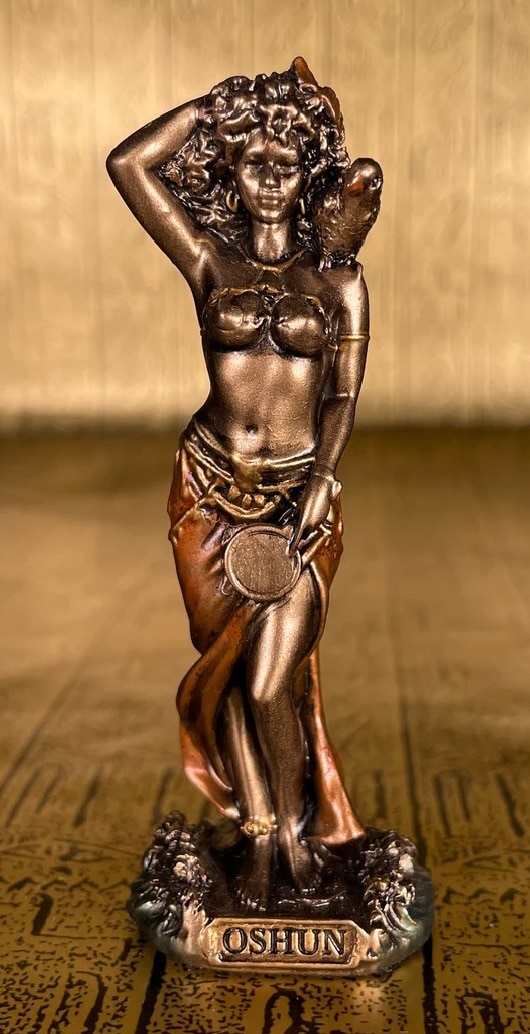
The Yoruba faith was developed by the people of Benin and Nigeria, and it consists of various rituals such as dancing, singing, as well as healing ceremonies. The Yoruba people believe that when we are born, we are assigned with one Orisha, which means the owner of our head, that accompanies us throughout our lives and acts as our protector.
In some parts of the United States, the Caribbean, and Latin America, the seven Orishas are worshiped. They’re also called The Seven African Powers and include:
- Obatala
- Eleggua
- Oya
- Yemaya
- Ogun
- Shango
- and Oshun
It’s believed that we have the same personality traits as our Orisha.
Myths About the Oshun Goddess

In many Yoruba myths and stories, Oshun is described as the savior, protector, mother and nurturer of sweet things and humanity, and the keeper of spiritual balance.
Oshun as a Creator of Life
In one of the myths, Oshun has a key role in the creation of life on Earth and humanity. Olodumare, the Yoruba supreme god, sent seventeen Orishas down to Earth to try and populate it. They were all male deities except Oshun and failed to complete the task. They needed the female deity to help them revive the Earth. She agreed to assist them, and by delivering her powerful, sweet, and fertile waters, she brought life back to our planet, including human beings and other species.
Therefore, she’s considered the goddess of fertility and life, and without her actions, life on Earth wouldn’t exist.
Oshun’s Sacrifice and Determination
Unlike the supreme creator god, Orishas liked living among the people on Earth. One time, the Orishas decided to stop obeying Olodumare because they thought they could run the universe without him. As punishment, Olodumare withheld the rains, drying up the lakes and rivers. Without the waters, all life on Earth was dying. The people begged the Orishas to save them. The Orishas knew that it was they who had angered the supreme god, not the humans, so they tried to summon him and bring back the rain. Since Olodumare was sitting far up in the heavens, he couldn’t hear them.
Oshun then turned herself into a peacock to try and reach him. The long journey exhausted her, and her beautiful and colorful feathers started to fall off as she was passing the sun. But the determined Oshun continued flying. Once she reached the supreme god’s home, she fell in his arms as a vulture.
Touched by her determination and bravery, Olodumare nurtured and healed her. Ultimately, he allowed her to bring the rains back to Earth, saving humanity. He also appointed her the messenger and the only mean of communication between his house and the rest of the world.
Oshun’s Sensuality and Beauty
It’s believed that Oshun had many husbands and lovers. One of her marriages that is the most prominent and the most commonly discussed is the one to Shango, the Yoruba deity of the sky and thunder. Due to her sensuality and beauty, she was also Olodumare’s favorite Orisha.
A Contradictory Myth
In contrast to the previous myth where the goddess is the creator who gives life to Earth, other myths portray her as the one who takes life away. The legends say that when the goddess is angry, she may send down massive rains, flooding the Earth. In other instances, she would withhold the waters, causing heavy droughts and destroying crops.
Significance of the Yoruba Water Goddess
According to African traditions, humans first encountered Oshun in the city of Osogbo in Nigeria. This city, also known as Oshogbo, is believed to be sacred and protected by the powerful and fierce water goddess, Oshun.
The legend says that the goddess granted permission to the people of Osogbo to build the city at the Osun River. She also promised to protect them and provide for them if they respected and worshiped her devotedly by praying, making offerings, and performing different rituals in her honor. This is how the Oshun festival came to be. The Yoruba people still celebrate it today. Each year, the Oshun followers come to the river to pay tribute to the goddess, offer sacrifice, and pray for better health, children, and wealth.
Along the banks of the same river, just on the outskirts of Osogbo, there’s a sacred forest dedicated to Oshun. It’s called Osun-Osogbo Sacred Grove and was established almost five centuries ago. The sacred forest holds various artwork as well as shrines and sanctuaries honoring the water goddess. In 2005, this large cultural area was appointed a UNESCO World Heritage site.
In West African cultures, Oshun is associated with the power of women and femininity and is particularly significant to women who want children. Those who may fight with fertility challenges call upon the goddess and pray for her help. More commonly, during the times of extreme poverty and severe droughts, the goddess is sought after to grant rains and make the land fertile.
Due to the global slave trade, the Yoruba religion and culture dispersed and greatly impacted other cultures outside Africa. Therefore, Oshun became an important deity in Brazil, where she’s known as Oxum, as well as in Cuba, where she’s called Ochún.
Oshun’s Portrayal and Symbolism
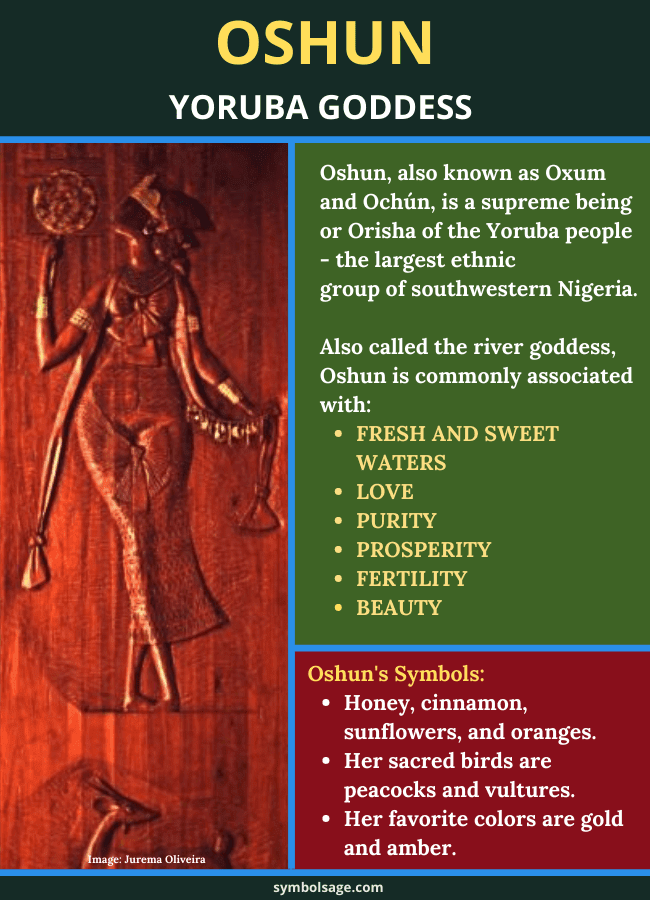
- Symbolism: As the Orisha of fresh and sweet waters, such as rivers, the goddess is associated with fertility, prosperity, and healing. It’s believed that she’s a protector of the waters as well as the poor and the sick, bringing them prosperity and health. As the Orisha or goddess of love, she represents beauty, marriage, harmony, ecstasy, romance, and pregnancy.
- Appearance: Oshun is often portrayed as a beautiful young woman that is playful, charming, and coquettish. She’s usually dressed and covered with golden clothes and jewels, carrying a pot of honey attached to her waist. Sometimes, she’s depicted as a mermaid, a woman with a fishtail, referencing her water goddess title. At times, she’s also portrayed carrying the mirror and admiring her own beauty.
- Symbols: The traditional Oshun’s colors are gold and amber; her favorite foods include honey, cinnamon, sunflowers, and oranges; and her sacred birds are peacocks and vultures.
Each of these elements has a specific symbolic meaning:
- The Color Gold
It’s often claimed that the goddess is fond of everything shiny and glittery, and as a complement to her beauty and charm, she’s usually wearing gold jewelry and ornaments such as golden beads, bracelets, elaborate fans, and mirrors. As a precious metal, gold is associated with prosperity, wealth, glamour, and beauty. The color gold, as well as yellow and amber, symbolizes compassion, love, courage, passion, wisdom, and magic.
- The Pot of Honey
It’s not accidental that Oshun is often depicted as wearing a honeypot around her waist. In many cultures, honey represents fertility and pregnancy, as well as male sexual pleasure. On the more spiritual side, honey represents an auspicious omen and a sign of good luck and joy. As a delicacy and luxury, it’s also associated with wealth, prosperity, and abundance.
As an homage to the Oshun goddess, many women from West and East African cultures traditionally wear golden beads and chains around their waists, as a symbol of fertility, femininity, sensuality, and happiness.
- Oshun’s Sacred Birds
The water goddess is often associated with vultures and peacocks. This is due to the story of Orishas, who rebelled against the creator god, Olodumare. In this context, Oshun and her sacred birds are seen as symbols of courage, perseverance, healing, waters, and life.
To Wrap It Up
Oshun is regarded as a benevolent deity according to the Yoruba faith, who governs the sweet waters of the Earth as well as love, prosperity, and fertility. She’s a protector of the poor and the sick, bringing them health, joy, dance, and music. Her stories teach us great divinity, compassion, and determination.






